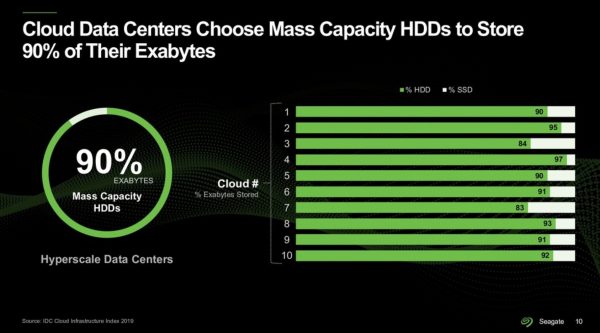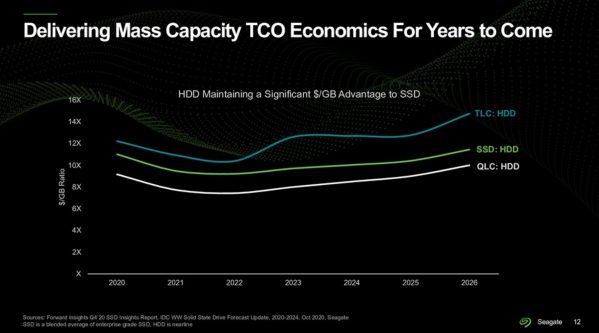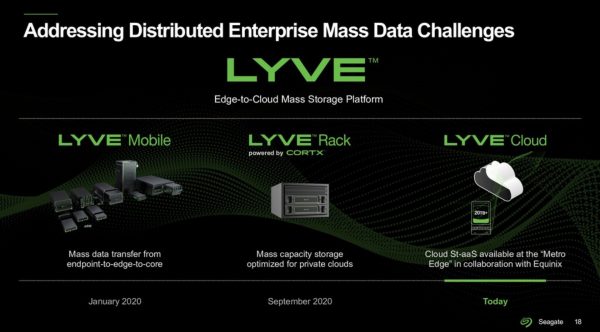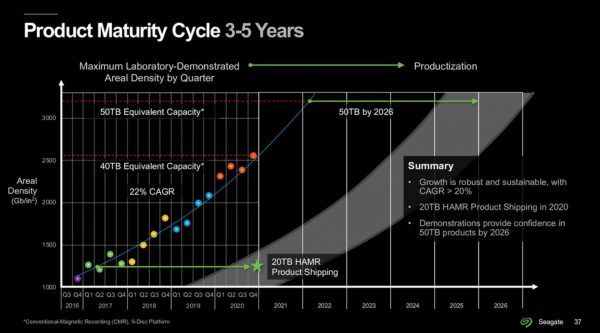Seagate Lyve Cloud Built to Store, Activate, and Manage Massive Surge in Data
Collaboration with Equinix brings additional access, compute, and data center colocation.
This is a Press Release edited by StorageNewsletter.com on March 9, 2021 at 2:32 pmSeagate Technology plc introduced Lyve Cloud storage-as-a-service platform, an S3-compatible storage-only cloud.
It enables always-on mass capacity storage and activation. It is designed as a simple, trusted, and efficient service allowing enterprises to unlock the value of their massive unstructured datasets. Seagate is collaborating with Equinix Inc., the digital infrastructure company, to make Lyve Cloud accessible to more customers. This collaboration will provide extensive interconnect opportunities for additional cloud services and geographical expansion.
“Lyve Cloud is a natural extension of Seagate’s leadership in mass data solutions, combining our mass capacity HDD innovation with deep storage industry knowledge to help customers activate more of their valuable data,” said Ravi Naik, executive vice president, storage services, and chief information officer at Seagate. “According to Seagate’s Rethink Data report, as much as 68% of data available to enterprises goes unused. By providing a reliable and cost-efficient cloud storage solution at the metro edge, closer to where their data is generated, Lyve Cloud lets enterprises store and activate their data at scale, securely and efficiently.”
By locating Lyve Cloud infrastructure in close proximity to Equinix Metal within Equinix International Business Exchange (IBX) data centers, customers can consume the scale and efficiency of object storage-as-a -service at the metro edge, while leveraging Equinix Fabric to interconnect sources of data to a variety of edge and cloud-based applications for hybrid and multicloud architectures. Placing Lyve Cloud infrastructure in metro edge colocation data centers also enables reduced latency because data is stored and processed closer to where it is generated.
“We see a lot of synergy in collaborating with Seagate to help our customers increase their digital advantage,” stated Eric Schwartz, chief strategy officer, Equinix. “Leveraging Lyve Cloud and Platform Equinix, customers have an optimized, cost-effective object storage option to make their cloud truly composable. Equinix’s position at the Metro Edge enables Lyve Cloud to address use cases that demand data storage and activation, accelerating digital transformation initiatives such as disaster recovery, hybrid and multi-cloud, storage for bare metal services, AI and ML.”
Lyve Cloud offers privacy, no lock-in, and no egress fees, allowing customers to retain control of their data while lowering TCO for storing massive datasets. Lyve Cloud’s ISO27001 and SOC2 certifications meet the data security needs of enterprise customers and provide always-on encryption for data in motion and at rest.
“Enterprises are increasingly recognizing the need to store more of their business-critical data for longer periods of time, not only for business continuity, but also to harness its potential for analytics and deep learning,” said Wenceslao Lada, vice president, technical alliances, Commvault Systems, Inc. “With Commvault’s seamless integration and full compatibility with Seagate Lyve Cloud, end-users now have a compelling new option for cloud storage that enables worry-free, longer term data retention with predictable cost economics and simple recovery capabilities.”
“As CIO, three things I most seek for from any solution are predictability, security, and no lock-ins,” said Sudhakar Chilukuri, CIO Lattice Semiconductor Corp. “Lyve Cloud features fit these needs very well. We don’t have to replace anything but can add Lyve Cloud for certain data workloads. It’s critical to choose a cloud storage strategy that has transparent pricing, no ingress, and egress fees, and is reliable and performant.”
Lyve Cloud and Lyve Solutions are built with mass data in mind. These solutions, including modular hardware and software, deliver a portfolio that streamlines data access, transport, and management for enterprise. Lyve Cloud is offered at multiple locations in USA and in other countries in the future.
Comments
Seagate is a HDD vendor and WW leader in this field for those who hesitate again to position the company, but historically never succeeds in trying to diversify outside its core business.
During the recent launch, the company has insisted on the mass capacity storage demand to validate their HDD strategy. This model is interesting as, at the same time, FujiFilm and IBM demonstrated large capacity tape prototype with a direction set and a calendar. The presentation showed also a strange message that misses a dimension again if you consider the slide below. Tapes are completely missing as Seagate says, based on IDC numbers, that Hyperscale Data Centers are only covered by HDDs and SSDs.
Implicitly Seagate confirms that HDD is a business led by US companies and flash by Asian companies. It reminds also the famous book from Andrew Grove "Only the paranoid survive" telling the story of Intel so big that the company has ignored the coming growing competition and new players.

Seagate picked the TCO angle to promote HDD against SSD but as many vendors do, the comparison is limited to the basic device itself and not an array or even not the association with software. Remember some pasts debate between tape and HDD when de-dupe arrived and people did HDD vs. tape which was wrong as you have to compare a tape library and a de-dupe array for the same usable capacity. Here it's again the same story. Some vendors sell full flash for primary and/or secondary storage and with intelligent de-dupe and erasure coding you can reach new economy levels and beat HDDs.
More globally, at scale especially for large secondary storage environments, 3 features are really key: data reduction coupled with erasure coding and associated with energy savings capability. Imagine to power 10 years 10PB of archived data on disk, it would be crazy, right? And imagine if de-dupe and erasure coding are not use, we should store more than 30PB...

This announcement is a surprise for a few reasons but also a confirmation.
First, Seagate jumps into the cloud with the new product iteration of the Lyve line, Lyve Cloud, this time with a S3 storage only available in the cloud.
Second, on the software side, Lyve Cloud is based on MinIO and not CORTX object storage software, which shows that the 2 calendar follow different paths. We could have thought that the Lyve Cloud solution would have been based on CORTX with all the noise made by Seagate for the CORTX launch and globally for a few months. Does Seagate really need to announce such solution now or wait CORTX to be ready. It's difficult to imagine that MinIO will be replaced by CORTX in the future when petabytes will be accumulated. In other words, it's another big win for MinIO, confirming the Tsunami we announced a few years ago.
The impact is visible also on the open source competition as some of them disappeared. Seagate chose open source software to maximize hardware revenue like several of hardware vendors do. The firm has to immediately differentiate its solution. It's the reason why Lyve Cloud doesn't charge any fee for egress thus being aligned with RStor or Wasabi.

Seagate reaffirmed its HDD directions with strong areal density trajectory with HAMR technology on the path to 50TB by 2026 with a promise of 100TB around 2030. The team also insisted on Mach-2 with its dual actuator technology that represents the future of large capacity HDDs. The team indicated briefly without any details that they signed recently an 8EB deal. Impressive.

But the main question is why Seagate need to do this? What is the goal as the firm competes directly with its own clients? It was the same question in the past when the company acquired Xyratex and promoted Lustre-based HPC storage. It was also the same question when Western Digital tried another market path with its platform and system line. At the end, WDC stopped this strategy and sold IntelliFlash to DDN and ActiveScale to Quantum.
So keep an eye on this Seagate strategy and on the Lyve Cloud adoption.














 Subscribe to our free daily newsletter
Subscribe to our free daily newsletter

